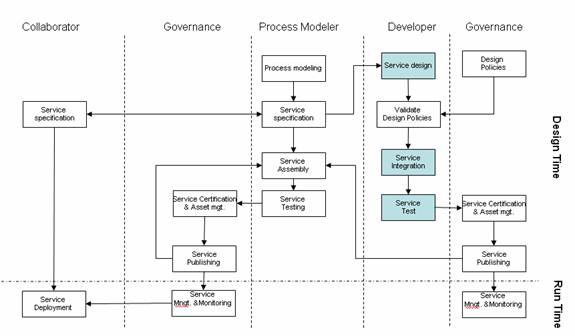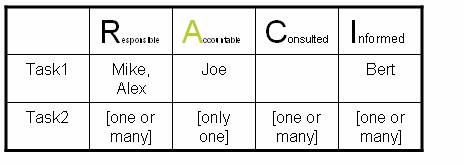Dov, thanks.
Team, First some
logistics? I?ve cc?d the collective email address for our group. The Colab
site (http://colab.cim3.net/cgi-bin/wiki.pl?WikiHomePage)
has some nice features available if we use its tools. We should also
use the Colab site file share features to share files like Dov?s. I?m
learning the ropes and will share what I learn. Others pls do provide
insight here.
I have learned that the
public wiki is quite easy to use. It is truly public, so we can all post.
I have posted an input from Brad Cox on a WikiPage http://colab.cim3.net/cgi-bin/wiki.pl?PgfsoaInfOutline
Our first task is to summarize key messages for our section. I
propose we use Brad?s input as the first draft and all of us add value wiki
style. Let?s see how that works and schedule any phone calls in response
to progress or lack thereof on the wiki.
Bob Farrow and I are
co-leads, and he and I had a good talk. I don?t think there will be any pride of
authorship issues between us. I have been appointed overall project
manager for the PGFSOA. I?m not sure exactly how much time/effort that
will require yet, but if I get swamped I?ll definitely ask for help.
Need a volunteer to
serve as principal editor and back up. Takers?
John Rollins, we don?t
have a phone number for you. Mind sharing? Thanks.
Regarding the specifics
of Dov?s note. Dov, I?ll call you to discuss. I certainly agree with
the need for a working ?lab? or ?factory? as a truly practical guide. My
personal agenda will be to make the Practical Guide actually practical.
I.e., focused on specific business objectives and based on working reference
implementations. In Dov?s world, that might translate to runtime
comparisons of DTS vs, e.g. Travelocity etc based on business-oriented
MOE?s.
Fyi, I am traveling all
next week, but will be responsive to email and calls to my cell. Best,
Chris
Chris
Gunderson
Research Associate
Professor of Information Science
Naval Postgraduate School
Principal Investigator,
Netcentric Certification Office and W2COG
Initiatives
www.w2cog.org
(O) 703 262
5332
(C) 831 224
5182
From: Dov J.
Levy [mailto:Dov.Levy@xxxxxxxxxxxxx]
Sent: Sunday, February 04, 2007 9:51
AM
To: RFarrow@xxxxxxxxxxxxxx;
Chris.Gunderson@xxxxxxxxx; bcox@xxxxxxxxxxxxxxx; vijay.raghavan@xxxxxxxxxxxxxxxx; jrolli01@xxxxxxxxxx
Subject: SOA Infrastructure
section
Hello,
Since I didn?t meet most of you, I thought that I will
introduce myself. My name is Dov Levy and I am the President of Dovèl
Technologies (www.doveltech.com).
The company has been involved over the years with system such as the EDGAR
system for the SEC, the Blood System for the American Red Cross, an emergency
Operations System for the FDA, the Defense Travel System (DTS) for
DoD.
We spent large amount of time on SOA. It all
started about 2 years ago as we wrote a technology Refresh Plan to migrate the
DTS to a newer technology. So I have an advantage that we wrote an
extensive document on this subject. Therefore, I am taking the liberty of
taking short extract from the document to see if you
agree
Based on my experience, there are a number of concepts
that are important (I am also attaching one of our SOA briefings just to give
you some insight to our angle on this). Especially, it is important to
establish a lab. We use factory terminology so we call it ?establish a
factory?, and than we say ?calibrate the factory? meaning establish all the
tool, techniques, and processes and calibrate it on some prototype. I can
explain further?
Please let me know what your thoughts are and how do we
want to move forward.
Thanks Dov
Dov
Levy
Dovèl
Technologies
Direct: (703)
288-5305
Mobile: (301)
520-2882
www.doveltech.com
In this plan, we
introduce new organizational roles and a Six Sigma management tool. SOA
introduces some new roles and responsibilities. Among them
are:
·
Business Process
modeler
·
Governance
team
Business Process
Modeler: Under the SOA effort, this individual or team, with
expertise in modeling business processes and workflows, will be required to
model the interaction and the flow between the services using a workflow tool or
business process-modeling tool. These individuals usually are considered SMEs in
their domain of business and are expected to have knowledge and experience in
the use of Business Process Modeling tools. Lack of expertise with tools will be
addressed through training or through teaming with individuals who have this
expertise.
Governance Team:
This team is responsible for assuring quality and consistency of the design
effort throughout all of the project phases. Usually its members are senior
individuals with proven experience in managing and delivering SOA. To assure
consistency in the design between the phases and among the multiple teams,
personnel changes within the governance team are discouraged. The team is
composed of:
·
Senior program
manager
·
Senior application
architect
·
Senior system
architect
·
Senior security
architect
·
Senior database/DW
architect
All team members
except the program manager are expected to have in-depth knowledge of SOA, Web
services protocol, XML, and J2EE.
The figure below
provides an example of the roles and the responsibilities of team members during
the modeling, development, and integration efforts.

Figure 7-1. Roles and responsibilities of
the Process Modeler, Developer, and the Governance team during design time and
run time
The Governance team will operate throughout
the three phases. Their responsibilities include:
·
Deliver a logical and
physical architecture
·
Define the Factory
processes, policies, and directions
·
Resolve technical
conflicts between the multiple teams
·
Maintain consistency
in modeling, design, development, testing and integration throughout the entire
refresh effort
·
Operate as mentors
and SMEs
·
Audit deliverables to
assure conformance
·
Collaborate with the
Sustainment team on requirements and integration efforts
The next section further defines the
governance team?s responsibilities and the governance
approach.
SOA is an architectural style whose goal is
to achieve simpler integration through reusable services. A service is a unit of
work delivered by a service provider with an expected outcome to the service
consumer. Services assume quality based on ?contractual agreements; design by
contract? or policies.
SOA offers more flexibility compared to a
traditional architecture, but at the same time it requires more loosely coupled
?moving parts?, many standards, and layers of standards (referred to as the
?SOAP Stack?).
Gartner predicts, ?Through 2006, SOA and ?designing for integration? will represent the largest
single innovation that reduces the cost and increases the effectiveness of
integration projects in large enterprises.? But at the same time,
they also state: ?Service-oriented
architectures built opportunistically with the purpose of "getting it over with"
as soon as possible, and at as low a cost as possible, will prove to be a
disaster for enterprises? software
infrastructures.?
A key success factor in SOA is establishing
SOA Governance. The SOA governance key roles and responsibilities
include:
·
Define business
requirements
·
Audit
design
·
Manage data
dictionaries
·
Define the logical
and the physical architecture in their domain of expertise
·
Establishing and
promoting best practices
·
Defining the
mechanisms to define and enforce DTS wide policy
·
Assuring design
quality and reuse
·
Enforcing design
conformance
·
Conduct
audit
·
Defining service
level agreements and service-oriented contract agreements
The magnitude of the technology refresh
initiative will make any attempt to manually govern and force conformance of
some common enterprise policies and standards futile. Hence, beyond run
time governance, it is imperative to use advanced automated-based governance and
conformance tools at the design stage to manage Web services and SOA.
During the design and development phase,
using innovative solutions like WebLayers Centertm to govern, audit
conformance, and enforce architectural and indirect business policies can
prevent significant challenges during the integration efforts. Due to the
complexities, wide coverage of SOA, and the use of multiple concurrent
development teams, design governance that is based on automation is critical.
The Defense Information Systems Agency (DISA) has selected WebLayers as the
design time governance software system for its NCES initiative. This selection
was following an industry-wide RFI that was submitted and evaluated by DISA, and
a detailed technical evaluation of WebLayers Center carried out for DISA by SAIC and MITRE that
resulted in a strong recommendation to select WebLayers Center.
To assure tight collaboration and
coordination between the multiple organizations, we plan for the Technology
Refresh Project Manager and the Technology Refresh team to use a Six Sigma best
practice tool called RACI (pronounced ray-see):
·
Responsibility ? People who are expected to
actively participate in the activity and contribute to the best of their
abilities.
·
Accountability ? The person (only one) who
is ultimately responsible for the results.
·
Consultation ? People who either have a
particular expertise they can contribute to specific decisions (i.e., their
advice will be sought) or who must be consulted for some other reason before a
final decision is made (e.g., finance is often in a consulting role for
projects).
·
Inform ? People who are affected by the
activity/decision and therefore need to be kept informed, but do not participate
in the effort. (They are notified after the final decisions are
made.)
The table breaks down between the tasks and
the role that each team member is filling. It is expected that each PM or Team
lead will develop, manage, and communicate the RACI to their relevant team
members.

Figure 7-2. The RACI
Model

